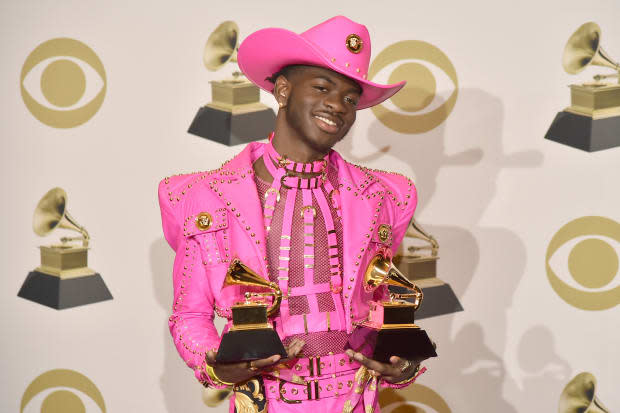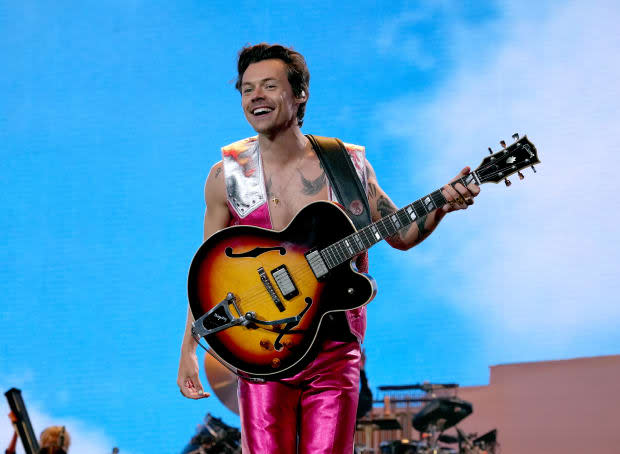The 'Space Cowgirl' Aesthetic Is a Gen-Z Fever Dream
- Oops!Something went wrong.Please try again later.
- Oops!Something went wrong.Please try again later.
Here's why you're seeing that pink feathered 10-gallon hat everywhere.
When Eliz Le's friend Isabella turned 21 earlier this year, there was only one way to celebrate: with a human-sized blow-up alien figurine.
That was, of course, in addition to a correspondingly erratic assemblage of props and accessories, including a plume of cow-printed balloons, an industrial bubble machine and a Barbie-pink feathered cowboy hat on each partygoer. But for Le, her friends and the thousands who later saw the festivities recapped on TikTok, the event wasn't erratic at all. It was, instead, a well-executed play on a femme, retro-futuristic aesthetic Le calls "space cowgirl," which is exactly what it sounds like.
"The space-cowgirl aesthetic is a style and trend hybrid where the past meets future," says Le, a 23-year-old filmmaker, photographer and creative director in Brisbane, Australia. "It's an aesthetic that Generation Z wants to explore, finding inspiration from the past Y2K fashion trends and wanting to add a new spin on them, such as love for robots, outer space and a new sci-fi realm."
Here's where you may have seen space cowgirls: Nashville bachelorette parties, Bama Rush TikTok, in the pit at Harry Styles concerts. It's holographic bodysuits and Western boots. It's disco balls and mechanical bulls. It's Kacey Musgraves. It's horse girls (Beyoncé's version). It's "Euphoria" makeup. It's "The Jetsons" meets "Fievel Goes West."
It's also, as Le tells me, a "feeling" — one that lives somewhere between nostalgia for the past and unabashed hope for the future, which she calls "the sweet spot of living in between." For a demographic like Gen Z that's come of age amid unprecedented uncertainty — and shoulders the burden of forging a tenable future through it all — the space cowgirl is an unexpectedly poignant respite.
View the original article to see embedded media.
The origins of the style aren't quite so contemporary. The spurs-kicking, lasso-whirling cowboy as we know it today in Western lore is just a whitewashed version of the Mexican vaquero, largely Indigenous men who were trained to wrangle cattle on horseback. When the Spanish landed in what is now Mexico in 1519, they built ranches to raise cattle where the vaqueros became hired hands — expert horsemen known for their roping, riding and herding skills. As colonial ranching made its way to Texas, New Mexico and Arizona, so, too, did vaquero culture; by the 1800s, it was an inextricable part of the American West.
"One of the earliest seeds we've seen of this aesthetic was Selena Quintanilla, whose fashion influence is still felt today," says Ruth Smart, a 28-year-old playwright, songwriter and creator in Chicago. "She took the Western styles from Texas, inspired by the vaquero, and incorporated hyper-feminine moments of bedazzled bras, belt buckles and the iconic glitter jumpsuit. She's the blueprint of the current trends we're seeing."
Now, Smart argues, we're seeing how this style has been augmented, amplified and reclaimed by various micro-communities, only to be diluted and eventually shared online. This, as we know, is the basis for the growing digital obsession with "cores," a suffix denoting a kind of style. Some, like that of the space cowgirl, have roots in appropriated cultures from around the globe; others, like "gorpcore," "menocore" and "cottagecore," are far less derivative, goofy reflections of hyper-specific internet aesthetics.
"Western in general has been having such a moment for the past few years," says Rebecca Jennings, a senior correspondent at The Goods by Vox, where she covers social media platforms, influencers and the creator economy. "These old-fashioned aesthetics are being repurposed in a way that's a lot more inclusive and diverse than they once were."
This is much to the credit of the new generation of country music artists bringing the genre out of its exclusionary, dirt-road past and into a more inclusive present. Kacey Musgraves' own high-glam Priscilla Presley cosplay is just the beginning, with Lil Nas X, Orville Peck, Maren Morris and a post-"1989"-era Taylor Swift all driving country music to a new destination together. That, as Smart notes, includes a bedazzled sort of makeover.
"They're all redefining what a country aesthetic is and could be," says Smart. "My favorite example will always be Lil' Nas X. His entire brand is built upon this very aesthetic, defining the reclamation portion of this emerging trend. I don't think I ever stopped thinking about his neon-pink Versace look from the Grammys. Iconic."

Photo: David Crotty/Patrick McMullan via Getty Images
Now, Harry Styles is no literal country artist, per se, in that he's never worn a 10-gallon hat on the Country Music Awards red carpet. But he is sneakily country-adjacent, and this influence has always been present in his albums, albeit in more "y'allternative" iterations.
His self-titled debut is full of plucky, country-inspired guitars and vocals. His second, "Fine Line," continues that tradition with songs like "Canyon Moon." Even his most recent album, "Harry's House," has tracks like "Boyfriends" that lean into Western-style sounds. Not to mention, he's previously recorded in Nashville and has a history of supporting and platforming country artists while touring — including Musgraves, Peck, Jenny Lewis and his latest Coachella masterpiece with Shania Twain.
"With all of this in mind, it does feel like an interesting moment as a Harry Styles fan, seeing him embrace this aesthetic in his touring wardrobe," says Smart. "Typically, the dynamic is the fans imitating Harry's style, but seeing the direction some of his tour outfits have been going, it kind of feels like a little bit of a reversal."
During Styles' Love On Tour in 2021, she explains, droves of fans flocked to his concerts decked out in their grooviest, yeehaw best, while he was on stage every night in high-waisted trousers, a button-down blouse and suspenders.
"Now, we're seeing him wear outfits that are definitely inspired by the aesthetic that the fans brought into the venues first," says Smart, "which really, all speaks to the talents of [stylist] Harry Lambert and how he constantly has a pulse on the current trends."

Photo: Kevin Mazur/Getty Images for Harry Styles
Why is the retro-futuristic space cowgirl scratching an itch we didn't even know existed? As a direct response to tumultuous social, political and economic times, some will look to cope with comfort via neutral capsule wardrobes, à la the hot-girl-walking, Set Active-wearing Aritzia girly. Others, though, will seek to find meaning in the chaos and camp of it all, and come out on the other side wrapped in a candy-pink boa, posing with a life-sized inflatable alien doll.
"The space cowgirl's entire premise is one based on joy," says Smart. "It's silly, bright and exciting, and that's the entire point. It makes people feel good."
This is, of course, the way Gen Z lives their lives: irreverent, surreal and surprisingly optimistic. These were individuals who were born between eras, from the economic boom of the 1990s to the throes of the Great Recession. Le, for one, was born in 1999, on the eve of the new millennium.
"With the possibilities of technology, it's amazing to think that visiting outer space is a reality," she says. "This 'dreamers' mindset has definitely enticed our generation to seek the next shiny thing."
Never miss the latest fashion industry news. Sign up for the Fashionista daily newsletter.
